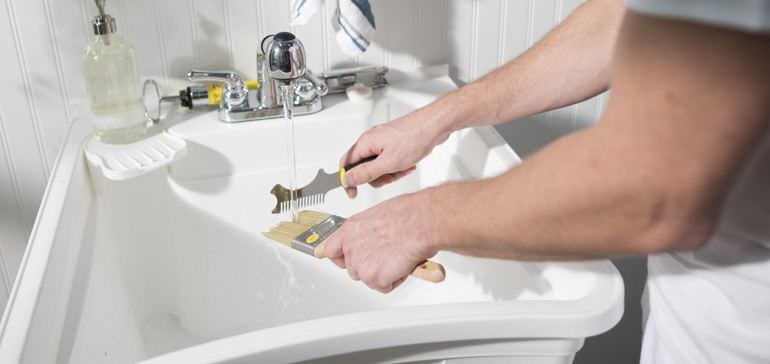Professional Painting Tools
Reducing waste on site
Reducing waste on site
12 September 2023

If not managed carefully, painting and decorating jobs can generate a fair amount of waste. This not only has an impact on the environment, but the financial cost of disposing of the waste can soon add up. There are some simple steps that professionals can take to minimise this, and sense checking that you are indeed ticking all the boxes is a worthwhile exercise.
Look after your tools
As any professional will understand, buying good quality brushes and rollers and looking after them correctly is important to help achieve an exemplary finish every time. It is also an excellent way to reduce waste. Cheap and low-quality products will not last nearly as long as professional standard tools and repeatedly throwing away brushes that are no longer usable results in significant and, often avoidable waste, especially over the course of a full career in the sector.
Experience will also tell you that the life of any brush or roller will be shortened if it is not cleaned and maintained properly. It is recommended to check the manufacturer’s guidance on how to clean and store brushes and rollers. It is also important to clean the tools in an environmentally conscious way. If you have an apprentice working with you, it is good to impart some best practice advice such as:
- Where a job is completed over a number of days, consider sealing the brush in a plastic bag at the end of the day rather than washing it.
- Use a brush comb to help remove paint more effectively and reduce the amount of water used.
- Avoid washing the brush under a running tap for extended periods. Wash the brush in a bucket or container of water and then rinse under a tap.
Buy just what you need
While it may sound obvious, one of the best ways to avoid waste is to carefully calculate how much paint is required to complete a job and only buy what is needed. Although some suppliers will offer refunds on the return of unopened containers, using only part of a large container can be wasteful. Again, explaining to those who are new to the trade the pitfalls of quick, rough estimates and how to calculate requirements accurately will help them start good habits early in their careers.
Leftover paint
Where there is paint left over at the end of a job it doesn’t necessarily need to be disposed of as there are a few options for reducing the waste. One of the most basic options is to store it for use on a future job. You can also mix leftover paint together and use it as a low-waste alternative to an undercoat, perhaps where a small quantity is required.
Furthermore, it may be worthwhile investigating if any local charities can use it. Often community projects and charities that provide temporary or emergency accommodation will take donations to help them cut material costs. This not only helps a good cause but also reduces the costs associated with disposal.
Cut down on packaging
Packaging is a significant part of the total volume of waste so where possible, look for products that have minimal packaging. For example, Purdy brushes are supplied in minimal packaging which is also designed to help maintain the brush shape long term – the keeper.. Also, try to buy the quantity of paint required in a smaller number of larger containers. Not only will this commonly provide a cost saving, but it will reduce the amount of waste packaging.
Waste is a serious issue, but there are some simple steps that can be taken to reduce it. In some cases, these techniques and suggestions will also save you time and money. This is an important message even for the most experienced of professionals – and for those mentoring an apprentice – one that is vital to pass on.

